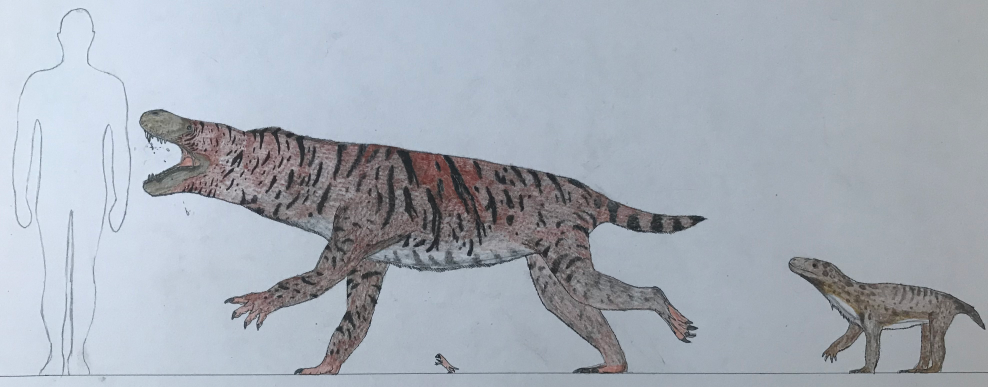HOME | DD
 Corallianassa — lycosuchids [outdated]
Corallianassa — lycosuchids [outdated]

#therapsida #pristerognathus #lycosuchus #scymnosaurus #tapinocephalus #simorhinella #lycosuchidae
Published: 2018-09-22 10:41:09 +0000 UTC; Views: 4290; Favourites: 115; Downloads: 8
Redirect to original
Description
In terms of large permian land predators, most will be familiar with the pelycosaurians such as Dimetrodon, large gorgonopsids such as Inostrancevia and the gigantic dinocephalian predator Anteosaurus - but a very rarely known clade of permian predators are the somewhat mysterious lycosuchids, represented by only two or three taxa and a lot of undeterminated remains.They´re the most basal therocephalians.
So far, lycosuchids have only been recovered from the middle-late permian Karoo and nowhere else, and only from the Pristerognathus and Tapinocephalus assemblage zones, with by far most remains from the latter.
Two species of Lycosuchus have been named: Lycosuchus vanderrieti and Lycosuchus mackayi. The latter is considered dubious. They reach a maximum skull length of 23 cm and the species is represented by 5 specimens confidently referred to it. Lycosuchus occurs throughout both assemblage zones.
Simorhinella baini is originally represented only by the miniscule holotype, a 2.2 cm long skull in an extremely early ontogenetic stage. The other Simorhinella specimen was later referred to the taxon. This referral is provisional because the holotype can not be compared very well with much older individuals, and was only done on the basis of few characteristics. It only occurs in the Tapinocephalus assemblage zone.
The adult specimen of Simorhinella baini has a 37 cm long skull, making it the size of a large dog. The specimen is not depicted here however....
The gigantic lycosuchid you see here is SAM-PK-9005, a large isolated snout known as ´Scymnosaurus major´. Kammerer considered this species undiagnostic and it is thus lycosuchidae incertae sedis.
Related content
Comments: 24

Nice! Love the color patterns for all of them, especially the colouration for SAM-PK-9005.
👍: 0 ⏩: 1

I had no idea that giant lycosuchid existed.
👍: 0 ⏩: 0

The big fellow looks like an especially ferocious selection from the Evolutionary History of Deep Time!
👍: 0 ⏩: 1

I hope you've been able to handle these beasties without losing any fingers ... or one of your wrangling team.
👍: 0 ⏩: 0

lycosuchids?
i think of lycans when i hear that 1st bit, so does that name translate to "wolf crocodile" by any chance?
👍: 0 ⏩: 1

Yep, it translates to wolf crocodile.
👍: 0 ⏩: 1

SICK
love guessing name meanings
👍: 0 ⏩: 0

Wow, this is really awesome! I love the patterning you gave them, and that's a really freaky set of limbs it has, almost human or hyena-like
👍: 0 ⏩: 1

Thank you. The limbs of these basal therapsids are indeed somewhat human-like (more bear like but with smaller hands)
Here is the preserved forelimb of the scylacosaurid Cynariognathus:
cdn.discordapp.com/attachments…
Simorhinella postcrania seems to be less bulky than that of Cynariognathus however.
👍: 0 ⏩: 1

d
e
s
c
r
i
p
t
i
o
n
(it is Simorhinella baini, the holotype)
👍: 0 ⏩: 1

Ik zag Simorhinella bijna over het hoofd...
👍: 0 ⏩: 0
































